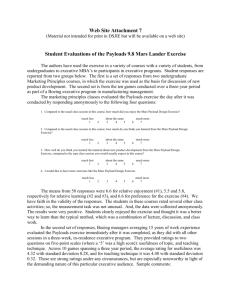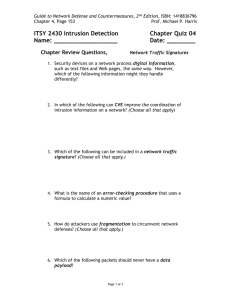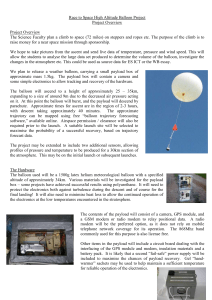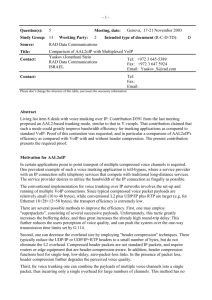Voice Traffic Performance over Wireless LAN using the Point
advertisement
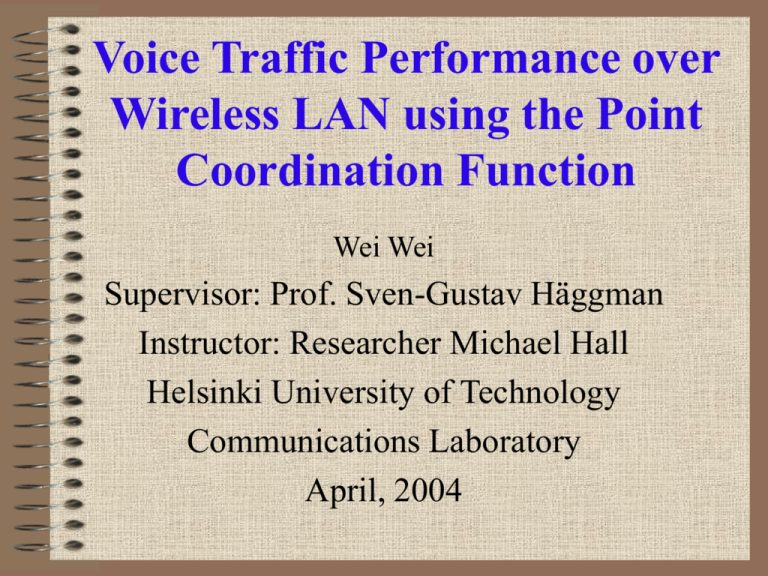
Voice Traffic Performance over Wireless LAN using the Point Coordination Function Wei Wei Supervisor: Prof. Sven-Gustav Häggman Instructor: Researcher Michael Hall Helsinki University of Technology Communications Laboratory April, 2004 Contents • • • • • • • Background Objectives Introduction to WLAN Simulation Results Conclusions Future work Why WLAN? • Mobility - It brings increased efficiency and productivity. • Flexibility - Fast and easy deployment. - Can be set up where the wired networks are imposible or difficult to reach. Voice over WLAN (1) • Nowadays, IEEE 802.11 WLAN standard is being accepted widely and rapidly for many different environments. • Mainly, WLAN is used for Internet based services like web browsing, email, and file transfers. Voice over WLAN (2) • However, demand for supporting real-time traffic applications such as voice over WLAN has been increasing. • To meet this need, IEEE 802.11 standard defines an optional medium access protocol, Point Coordination Function (PCF). Objectives • To implement the basic PCF algorithm in a timedriven simulation program written in C language. • To measure some metrics such as throughput, delay, frame loss rate, etc. • To evaluate the voice traffic performance in WLAN using PCF to investigate if PCF is capable of the real-time applications such as voice service. Network architecture (1) Network architecture (2) • Basically, WLAN network consists of four components: Distribution System, Access Point, Mobile Station, and wireless medium. • Distribution System (DS): - A backbone network that connects several access points or Basic Service Sets. - Wired or wireless, implemented independently. - In general, Ethernet is used as the backbone network technology. Network architecture (3) • Access Point (AP): - Connected to the DS, wireless-to-wired bridging function. • Mobile Station (MS): - In general, it’s referred to laptop computer. • Wireless medium: - Frequency Hopping, Direct Sequence Spread Spectrum, Infra-red. Network architecture (4) • Basic Service Set (BSS): - It consists of a group of stations that are under control of DCF or PCF. • Extended Service Set (ESS): - It consists of several BSSs via DS. - Provides larger network coverage area. Network architecture (5) • IEEE 802.11 defines two operation modes: Ad-hoc mode and Infrastructure mode. • Ad-hoc mode: - A set of 802.11 wireless stations communicate directly with each other, without using access point. - Also called Independent Basic Service Set (IBSS). Network architecture (6) • Infrastructure mode: - The network consists of at least one access point and a set of mobile stations. - AP bridges the wireless traffic to a wired Ethernet or the Internet. - AP can be compared with a base station used in a celluar network. IEEE 802.11 MAC layer • IEEE 802.11 defines two medium access methods: the mandatory Distributed Coordination Function (DCF) for non-realtime applications, and the optional Point Coordination Function (PCF) for real-time applications. DCF • Basic access method of IEEE 802.11, using Carrier Sense Multiple Access with Collision Avoidance (CSMA/CA) to access to the shared medium. • Backoff before transmission, provide fair access to the medium. • No QoS guarantees, best effort. PCF • Optional access method, resides on top of DCF. • To support real-time applications. • Centralized control. • Polling based access mechanism. Coexistence of DCF and PCF Taken from IEEE 802.11 standard Inter-Frame Space (IFS) • • • • • • Basically 3 different IFSs. Short IFS (SIFS) PCF IFS (PIFS) DCF IFS (DIFS) SIFS < PIFS < DIFS IFS determines priority: - After a SIFS, only polled MS can send - After a PIFS, only AP can send (PCF control) - After a DIFS, every station can send according to CSMA/CA (DCF) PCF operation (1) • The time on the medium is divided into two parts: Contention-Free Period (CFP) controlled by PCF and Contention Period (CP) controlled by DCF. PCF operation (2) • During a CFP, at least 2 maximum size frames transmitted. • During a CP, at least 1 maximum size frame transmitted, including RTS/CTS and ACK. PCF operation (3) PCF polling scheme (1) • A poll list is created when the MSs supporting real-time service negotiate with Point Coordinator (PC) during the association procedure. • The MSs are put on the poll list in order. • The poll list gives the highest privilege to PCF supported MSs. PCF polling scheme (2) • The polling scheme is based on Round-Robin scheduler recommended by IEEE 802.11 standard. • Only the polled MS can transmit a frame. • During one CFP, the MS can be polled once. • If the CFP terminates before all MSs on the poll list are polled, the poll list will resume at the next MS in the following CFP. • The CFP may terminate befor time, if all MSs on the poll list have no data to send. • Data frame, ACK, and poll combined to improve efficiency. Simulation scenario • A single BSS in an infrastructure network configuration. Simulation model assumptions (1) • Only use voice traffic during CFP, not consider data traffic during CP. • RTP/UDP/IP/MAC/PHY, this adds an overall overhead of 78 bytes to every voice packet. • G.711 PCM voice codec used, fixed traffic interval 20ms or 40ms, 160bytes or 320bytes payload, respectively. • Buffer size = 1. Simulation model assumptions (2) • Power saving mode is neglected. • Foreshortened CFP is neglected. • Fragmentation/Defragmentation is neglected. • Broadcast/Multicast frames not considered. • Mobility, multipath interference, and hidden-node problem are not considered. • Basic rate used: 11 Mbps. Functions included in simulation (1) • One access point and specific number of VoIP stations • Voice connections: bi-directional deterministic stream of frames with calculated duration and inter-frame interval, PCM over RTP over UDP over IP over LLC over MAC over PHY assumed • SIFS and PIFS times Functions included in simulation (2) • Acknowledgement, beacon, CF-poll, and CF-end frames • Piggybacking of Ack and CF-poll information • Random generation of erroneous frames • Recording of simulation data Simulation parameters Channel rate Channel frame error rate (CFER) Voice payload Slot time SIFS PIFS DIFS 11 Mbps 0.03 160/320 bytes 20 s 10 s 30 s 50 s Metrics • • • • • Superframe size Maximum number of VoIP MS Throughput Frame loss rate Access delay Results: superframe size • Normalized throughput for different SF using 160-byte payload Normalized throughput 160-byte payload traffic interval=20ms, CFER=0.03 1 0.9 0.8 0.7 0.6 0.5 0.4 0.3 0.2 0.1 0 SF10 SF15 SF20 SF25 SF30 5 10 15 20 25 30 Number of VoIP MS 35 40 Results: superframe size • Normalized throughput for different SF using 320-byte payload Normalized throughput 320-byte payload traffic interval = 40ms, CFER = 0.03 1 0.9 0.8 0.7 0.6 0.5 0.4 0.3 0.2 0.1 0 SF30 SF35 SF40 SF45 SF50 5 10 15 20 25 30 35 40 Number of VoIP MS 45 50 Results: max. number of VoIP MS for 160-byte payload Normalized throughput 160-byte payload traffic interval = 20ms, CFER = 0.03 1 0.95 0.9 0.85 0.8 0.75 0.7 0.65 0.6 0.55 0.5 SF20 0 5 10 15 20 25 30 35 Number of VoIP MS 40 45 Results: max. number of VoIP MS for 320-byte payload Normalized throughput 320-byte payload traffic interval = 40ms, CFER = 0.03 1 0.95 0.9 0.85 0.8 0.75 0.7 0.65 0.6 0.55 0.5 SF40 0 5 10 15 20 25 30 35 40 45 50 55 Number of VoIP MS Results: capacity Capacity (Mbps) SF20 160-byte payload vs. SF40 320-byte payload CFER = 0.03 5 4.5 4 3.5 3 2.5 2 1.5 1 0.5 0 SF20 SF40 0 5 10 15 20 25 30 35 40 45 50 55 Number of VoIP MS Results: frame loss rate SF20 160-byte payload vs. SF40 320-byte payload Frame loss rate 0.6 0.5 0.4 SF20 SF40 0.3 0.2 0.1 0 0 5 10 15 20 25 30 35 Number of VoIP MS 40 45 Results: average access delay for different SF using 160-byte payload 160-byte payload traffic interval = 20ms, CFER = 0.03 Access delay (ms) 12 SF10 SF15 SF20 SF25 SF30 SF35 SF40 10 8 6 4 2 0 5 10 15 20 25 30 Number of VoIP MS 35 40 Results: average access delay for different SF using 320-byte payload 320-byte payload traffic interval = 40ms, CFER = 0.03 Access delay (ms) 25 20 SF30 SF35 SF40 SF45 SF50 15 10 5 0 5 10 15 20 25 30 35 40 Number of VoIP MS 45 50 Results: comparison of average access delay btw. 160 and 320-byte payload Access delay (ms) SF20 160-byte payload vs. SF40 320-byte payload CFER = 0.03 20 18 16 14 12 10 8 6 4 2 0 SF20 SF40 0 5 10 15 20 25 30 35 40 45 50 55 Number of VoIP MS Results: cumulative delay distribution for 160-byte payload Cumulative percentage of packets Delay distribution for 160-byte payload CFER = 0.03 1 0.8 SF10, SF10, SF20, SF20, 0.6 0.4 0.2 0 0 10 20 30 Delay (ms) 40 50 V=10 V=20 V=10 V=20 Results: cumulative delay distribution for 320-byte payload Cumulative percentage of packets Delay distribution for 320-byte payload CFER = 0.03 1 0.8 SF20, SF20, SF40, SF40, 0.6 0.4 0.2 0 0 10 20 30 Delay (ms) 40 50 V=10 V=20 V=10 V=20 Conclusions • The proper superframe size should be approximately similar to the traffic interval, which results in good performance. • Longer payload provides higher normalized throughput and lower frame loss rate, but longer access delay. • Maximum number of VoIP MS: for 160-byte payload, 21; for 320-byte payload, 36. • When the number of VoIP MS increases, performance degrades dramatically. PCF provides limited QoS. Future works • Perform an authentic evaluation in a WLAN - Assumptions - Realistic traffic model • PCF problems - unpredictable Beacon frame delay resulting in shortened CFP - unknown transmission time of polled stations making it difficult for PC to predict and control the polling scheldule for the remainder of CFP • IEEE 802.11e introduced EDCF and HCF to support QoS Q&A Thank you for your attention!

